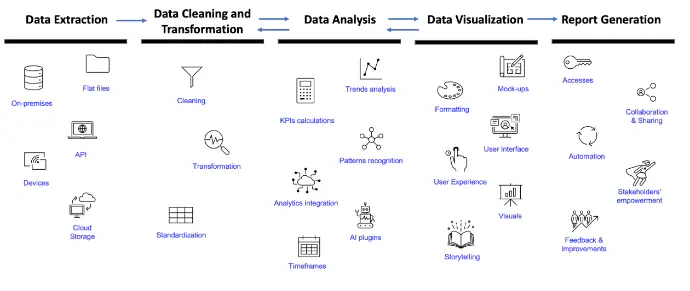Reporting automation in 2025
In today’s data-driven era, as many as 80% of companies report implementing data-based strategies to improve decision-making processes [IDC]. Within this context, reporting automation emerges as a game-changing solution offering substantial benefits. ccording to Gartner, by 2026, half of all Business Intelligence (BI) tools will not only structure data but also use metadata to generate personalized insights data storytelling, and contextual action recommendations [Gartner]. Below is an example of a report that enables reporting automation:
In this blog post, we’ll walk through the key aspects of reporting automation – from understanding its role to choosing the right tool tailored to your business needs.
What is Reporting Automation?
Reporting
Data analysis
Manual work elimination
Benefits
Reporting automation refers to the use of specialized tools to collect, analyze, and visualize data in a clear and intuitive way. It’s a critical solution for managers tracking team performance, data analysts, and decision-makers who rely on key metrics for strategic planning.
Modern BI tools enable automatic data fetching from multiple sources—such as databases, spreadsheets, or cloud platforms. Once collected, the data is processed and transformed into readable reports, including charts, tables, and interactive dashboards. The primary benefit of reporting automation is the elimination of manual work and the immediate access to up-to-date and consistent data.
Read case study about nearly 1000 KPIS reporting automation in bankingKey benefits of reporting automation:
📊 Time savings – reports update in real time, eliminating the need for manual generation and significantly reducing analysis and response time.
🔍 Improved data quality – automation minimizes human errors and ensures data consistency across the organization.
📈 Advanced analytics – modern BI tools offer trend analysis, forecasting, and interactive dashboards to support better decision-making.
🤝 Collaboration made easy – reports can be easily shared across teams, fostering transparency and cooperation.
Reporting automation is the backbone of modern data platforms and a crucial element of every company’s data ecosystem. Depending on your needs, there are solutions ranging from universal BI tools to industry-specific applications tailored to certain data types. Whether you choose an on-premises system or a cloud-based one, reporting automation is key to smarter data management and better business decisions.
What’s the Purpose of Reporting Automation Tools?
Key functions
Data preparation
Data analysis
Data visualisation
Report preparation
Reporting automation boosts operational efficiency, improves customer journeys, and empowers employees to make informed decisions. No matter the size or industry of your company, the right BI tools deliver valuable insights that directly contribute to increased profitability.

Core Features of Reporting Automation:
- 📊 Data consolidation – centralizes data from various sources into a single platform, simplifying access and management.
- 🔍 Data analysis – filtering, sorting, and processing enable faster trend identification and better decision-making.
- 📈 Data visualization – turns complex data into understandable charts, dashboards, and reports, improving internal communication.
- ⏳ Real-time decision-making – automatically updated reports provide access to current information, enhancing business agility.
- 🤝 Collaboration and sharing – easy report sharing supports knowledge exchange and team alignment.
- ⚙️ Increased efficiency – eliminates repetitive reporting tasks, freeing teams to focus on strategic work.
- 🛠 Customizable reporting – tailors reports to specific business needs and stakeholder expectations for maximum relevance.
How Do Reporting Automation Tools Work?
Connecting data from multiple systems
Real-time reporting
Time savings
BI tools automate the collection, transformation, analysis, and visualization of data. They pull information from various systems—such as databases, CRMs, and cloud storage—then clean and prepare it for use.
Using built-in analytics and Business Intelligence technology, they identify patterns, trends, and key insights. Results are presented via visual dashboards, tables, and interactive charts, enabling fast interpretation and action.
Check top reporting automation tools in 2025
Real-time reporting capabilities ensure up-to-date insights that support accurate and timely decision-making.
Reporting automation is not just a time-saver - it’s a foundation for modern data management and a catalyst for unlocking the full potential of business analytics.
How to Launch a Reporting Automation Project?
Business benefits include: reduced manual work, quicker access to key data, and better decisions. The implementation should follow a phased approach to gradually increase automation maturity:
Discovery
📌 Identify key reports to automate
📌 Understand business needs and data sources
📌 Select suitable reporting automation tools
Prototype
📌 Build initial automated reports
📌 Connect BI tools with databases and data sources
📌 Test report accuracy and performance
Integration
📌 Automate data update schedules
📌 Improve reporting workflows and data quality
📌 Integrate with other systems (ERP, CRM, Odoo, etc.)
Rollout
📌 Train teams to use BI tools
📌 Monitor results and fix errors
📌 Prepare for scalability and advanced analytics
Reporting Automation = Cost Savings
Tired of managing manual spreadsheets? Let’s talk!